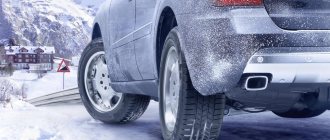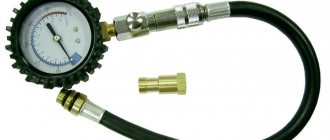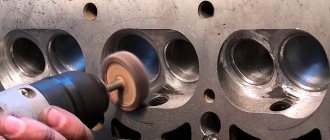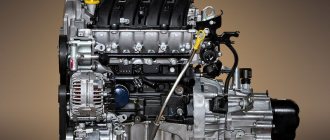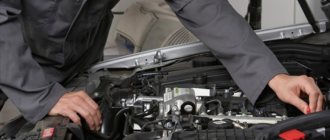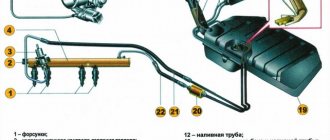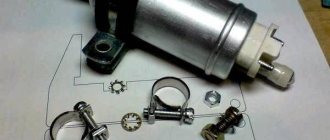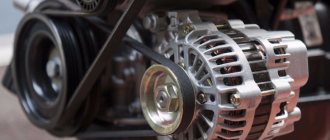- How to start a diesel engine in cold weather: help for motorists
- Is it possible to start a diesel engine in cold weather using a pusher?
- Starting a diesel engine in cold weather from a tugboat
- Tips on how to start a diesel engine in cold weather
In order to easily start a diesel engine in cold weather, you should constantly take into account some factors:
- reliable engine;
- starter is in working order;
- quality fuel.
Moreover, the main condition is often called normal compression. Therefore, if any of the indicated points does not work as it should, and therefore, the diesel engine will not start in cold weather. Therefore, before the cold arrives, it is advisable to recheck the entire engine at a workshop. If it smokes, it means it lacks power or is running unevenly. This is one of the indicators that characterizes the entire operation of the motor.
You can check a diesel engine using a pressure gauge, which is connected to the injector. As a result, the working pressure in the cylinder is checked. If the car is new, then this indicator must be at least 30 - 40 bar. When measurements reveal that the working cylinder of a diesel engine has a pressure of less than 20 bar, then we can safely state the fact that the car will have problems starting in winter. As a rule, all this occurs on cars that have a high mileage, where the engine is already worn out. Consequently, a major engine overhaul or a warm garage is required for the winter. Since even the most worn-out engine starts up without any problems in warm weather.
Looking for a “common denominator”
How to start a diesel engine in cold weather? First, let's look at the reasons for poor engine starting at low temperatures. Let's say right away that there are a lot of them. But most of them have a common denominator - liquids. Moreover, the lower the ambient temperature, the worse the engines will work.
In the case of a diesel engine, frost affects the fuel. With a rapid drop in temperature, it begins to thicken, causing the composition of the liquid to change. As a result, the fuel is difficult to ignite or does not pass through the fine filter at all.
A battery is also associated with liquids, in which chemical processes constantly occur (generating electric current). And the lower the air temperature, the slower they occur.
Another reason for poor starting of a diesel car can be engine oil. It, like fuel, also tends to thicken. Thus, as the temperature drops, the movement of the rubbing parts of the crankshaft becomes more difficult. It’s even worse if the oil film breaks or disappears altogether. Then a major overhaul of the power plant is inevitable.
2- install preheater
The pre-heater helps to warm up the engine or autonomously heat the interior even before starting the internal combustion engine.
Pre-heaters can operate on fuel (gasoline, diesel) and electricity (autonomous such as Webasto or battery-powered).
Liquid (gasoline, diesel) heaters are equipped with their own combustion chamber, fuel pump, and water pump. Some also have a remote start system and a heater fan control unit.
The principle of operation is this: the fuel burns in the heater chamber, a heat exchanger passes through it, through which the antifreeze supplied by the pump circulates. When heated, the coolant transfers heat to the engine.
Recommendations for choosing a liquid heater - do not choose one running on diesel fuel. In severe frost it will thicken and questions will arise as soon as the device itself is started.
When choosing a heater with an electrical power supply system, it is important to consider the availability of its connection to the network.
Autonomous heaters of the Webasto type are liquid and air.
Air units are placed in the cabin and maintain a comfortable temperature even before the engine starts. They run on fuel from a tank or their own chamber. The fuel is mixed with air and ignited by a glow plug, burning inside a closed chamber with an external fan blowing. As a result, hot air enters the cabin.
Liquid ones are installed in the engine compartment and operate from fuel combustion in the tank. They are connected to the cooling system circuit, pumping antifreeze through heated ceramic pins.
Then the heated coolant is supplied to the engine in a small circle through the heater radiator. After heating the coolant to 40 degrees, the cabin heater fan automatically turns on. The result is a warm engine and a warm, comfortable interior before the trip.
When choosing any preheater, the main thing is to connect it correctly. Otherwise, the cooling system may be damaged.
- To connect the heater, you need to disconnect the battery, drain the liquid from the cooling system, disconnect the pipes, place a heater between the heater and the cylinder block, connect the pipes and fittings so that the liquid first enters the device and then is supplied to the heater, pour antifreeze back in.
If you constantly use preheaters at low temperatures, you can extend the life of a diesel internal combustion engine and start it without problems even in severe frost. But the cost of such devices is high. In the case of Webasto, you need to monitor the battery charge level - it consumes quite a lot of electricity.
If the car spends the night in an insulated garage, and the temperature outside does not drop below 5-10 degrees, a car blanket will be enough to make starting the diesel engine easier.
How to start a diesel engine in winter? First start
If your vehicle doesn't start the first time, there's no need to panic. This process should last no more than 15 seconds. After this, you should turn the key to its original position and let the battery “rest” for one or two minutes. Ideally, the car should start in a maximum of 3 attempts. If your car still won't start, be sure not to repeat this process many times. This will only worsen the performance of the starter and drain the battery.
Starting using the “lighting” method
In winter, always keep ready-made cables in reserve. Thanks to them, you can start your car quickly. Not only an acquaintance, but also any friendly driver passing by you can help you.
If the car can be started using the “lighting” method, it can safely drive on. But it is worth noting that you should not turn off the engine immediately after ignition. Allow the battery to be fully “saturated” with electricity by driving at least 5 kilometers. It is best to let the engine run for about an hour. In this case, the battery will definitely resume its charge and provide normal starting current the next time it is started.
Use of additives and antigels
So, our car froze. How to start it if there is no suitable car nearby from which you could “light it”? In this case, welcome to the world of additives and antigels. Fortunately, finding them is not difficult, even in small towns. Often, car enthusiasts give preference to such well-known ones as “Hado” and “Castrol”. Due to their composition, they do not allow the paraffin contained in diesel fuel to multiply in full. The fact is that when the temperature drops, this fuel begins to become cloudy, forming a special sediment. Because of this, diesel fuel does not enter the combustion chamber, getting stuck in the walls of the filter.
We also note that additives and antigels do not dissolve paraffin in liquids; they only retard its growth with the next decrease in temperature. But, as practice shows, this is quite enough to start a diesel engine at 40 degrees below zero. True, for this you need to know how to use the antigel correctly. And it is poured into the tank at a temperature above 0...+1 degrees Celsius. In this case, the product brings real benefits to the engine.
Tricks for replacing an engine under warranty
Secondly, many car owners resort to various tricks to get a diesel engine replaced under the factory warranty. Such motivation, even if a little dubious, still exists. There are a number of ways to quietly break a diesel unit. Basically, it all comes down to a decrease in the oil level, which negatively affects the chassis and power parts.
The oil is slightly drained so that the oil level indicators on the panel begin to beep, this leads to “oil starvation” of the mechanical parts and knocking noises will appear. After fixing problems with the engine, you can simply add oil and contact the warranty authorities. Just remember that for the stealth effect, the oil should be drained through the neck from above.
The next, less popular methods are causing artificial corrosion; for this purpose, ordinary household chemicals are used - “Whiteness”. According to experimenters, such a mixture can cause instant corrosion of metal parts; for this purpose, the product is poured into the tank.
After a short period of engine operation, the entire chassis will become unnaturally rusty. Moreover, repairs after all this will be very difficult. After adding such an ingredient, the engine will smoke and stall.
The following methods involve deliberately reducing the level of antifreeze or antifreeze, which leads to overheating of the engine and damage to the piston system. You can also pour regular Drying Oil, used in painting, into the gas tank; this will also have a negative effect on the pistons. Aviation kerosene poured into the tank will affect the spark plugs and pistons due to its detonation.
Sometimes a solvent with number 646 is added to the oil; such a mixture will not allow the formation of an oil film in friction areas with all that it entails.
Below we will answer the question: how to kill diesel engines in natural ways
A sure way to ruin a diesel engine is to operate the car in extreme conditions. It is no secret that modern manufacturers include a safety margin of approximately 500 thousand kilometers in their engines.
It should be said that this is a pretty good reserve, unless, of course, you are going to the moon by car. The factory safety margin of the engine depends on compliance with the gear shift table.
In normal urban conditions this is 60-80 km/h, and 130-150 km/h on the highway. And also in the calculation of strength, compliance with the rules for accelerating the speed of a diesel engine is included. While driving, these are 4th and 5th gears; gears below these values are recommended only for gaining speed. Add to all this modern urban realities like traffic jams with its constant braking and slow traffic.
However, all these factors taken together are taken into account by manufacturers. But, if you are determined to kill the engine, then ignore all the rules and recommendations described above. Break the speed chart, accelerate in low gears, and vice versa, move slowly in high gears, start in a high gear. At best, a diesel engine will withstand such treatment for 2-3 years.
Water hammer
Use tall puddles. Accelerate and drive into a puddle at high speed; as a result, a surge of water will fill the engine compartment and pass through the air filter. Water can enter the piston system, causing a conflict with the rotation of the crankshaft, which is how water hammer occurs. The consequence of all this is a major overhaul.
Rare oil changes
Violate the engine oil change schedule. According to the instructions, the oil needs to be changed every 10 thousand km, increase this period by two to three times. You'll save on oil and help yourself ruin your engine. In principle, a car can travel 30 thousand kilometers on one oil fill, but the condition of the power unit will be catastrophic.
After repeated dry circulation, the oil will simply turn into fuel oil. The first serious signs can be noticed after 7 thousand km above normal after an oil change; these are frequent overheating, noise and frequent breakdown of components.
Illiterate use of additives
The indiscriminate use of all kinds of fuel and oil additives will also help to kill a diesel engine prematurely. Fill in additives without any system or need to read the instructions. Buy cheap additives directly at the gas station; they will effectively clog the fuel supply system.
Improper radiator care
Do not pay attention to the contamination of the radiator; let it become clogged with road debris, such as fluff, insects, etc. Economic car owners usually monitor the cleanliness of the radiator. But if you are planning to kill the engine, then do exactly the opposite. A dirty radiator is a guaranteed overheating of the engine and a malfunction of the air conditioning system.
Improper timing belt maintenance
There is also a safety margin for timing belts. Manufacturers usually recommend changing it after 60-70 thousand kilometers, including replacing rollers. If wear occurs earlier, it is recommended to replace it immediately. Replacing the belt will cost around $150, so think about whether it's worth shelling out that much? It’s better to continue driving with a worn belt, it will be more economical! Maybe it won't break!
If it does break, it is better if it happens within the city, and not somewhere on an international highway. Depending on the design of the unit, the timing belt is located close to important components, therefore, if it breaks, it can damage the engine valves, and this is a guaranteed repair for $600.
So neglect the timing of belt replacement. If you still want to be on the safe side, check the condition of the belt every 15 thousand km, paying attention to the white threads on the belt tape and low tension.
Neglecting the condition of the glow plugs
Change glow plugs rarely. Do not worry. You can completely forget about their existence and walk for kilometers. In the best case, you will last 80 thousand without having to replace the kit. You'll be lucky if you use high-quality fuel for refueling, but in reality it's rare that you can choose something of high quality.
Most likely, after about 30 thousand kilometers the spark plugs will need to be replaced, and with very poor fuel quality, even 15 thousand will be the limit of their life. If you do not change the spark plugs on time, the result is the accumulation of gases in the combustion chamber. It will be difficult for the spark plug to produce the required sparks and eventually detonation will occur, followed by wear or destruction of the piston edges.
Poor quality fuel
As mentioned above, cheap diesel fuel leads to wear of the spark plugs. Save on the quality of fuel; if you have to choose, save a few pennies by filling up with cheap slop, which sometimes can hardly even be called diesel. Most often this is chemical production waste. .
Water instead of Antifreeze!
Feel free to use plain water instead of standard coolant. What difference does it make, because the main thing is that there is liquid. The cooling system will quickly become unusable because the water forms scale. To clean the system, use water with lemon juice, do not use alkaline solutions, and do not skimp on antifreeze.
The cooling system will be completely covered in scale, and within three months the cavitation effect will reliably kill the engine. Cavitation is power! Bubbles can completely destroy the system right down to the holes in the cylinder liners.
Poor quality filters
Buy filters only from cheap brands. They can most likely be found on open markets selling surrogates. Such filters have low-quality elements and a non-functioning valve. Both factors qualitatively spoil the engine. All debris will settle in the unit. Cheap filters often break, opening a direct path for dust to flow towards the engine.
Nuances of antigels
Modern automakers do not recommend the use of additives in fuel. This applies to TDI, HDI and CDI engines. This ban is explained by the complexity of the design of fuel equipment. But car enthusiasts say that when used carefully and in moderation, the additive does not cause any harm to diesel engines.
When using antigels, it is important to pay attention not only to the ambient temperature, but also to the proportion in which liquid should be added to the tank. Manufacturers indicate this information on the labels.
Petrol
But this type of petroleum product should be completely deleted from the list of used “heaters” for diesel engines. The fact is that gasoline, unlike additives and kerosene, does not have lubricity. This means that while the engine is running, the fuel injection pump will pump liquid “dry”. Therefore, before starting a diesel engine in cold weather in this way, remember that repairing fuel equipment can cost from 200 to 500 Euros. In extreme cases, it is recommended to dilute gasoline with oil.
Glow plugs
Before starting a diesel engine in winter, you need to thoroughly warm up the spark plugs. How to do it? First, you need to turn the ignition key, then wait until a spring-shaped light appears on the instrument panel. Most often it is yellow or red (you can see it in the photo below).
After a couple of seconds it disappears, informing that the fuel has warmed up sufficiently. After this, return the ignition key to its original position. To completely warm up the glow plugs, it is necessary to repeat this procedure several more times with an interval of 2-3 seconds. The fact is that foreign manufacturers do not quite know what kind of low temperatures their cars have to face in Russia, especially in the northern regions. During this period, the fuel mixture is simply not able to warm up normally, so this procedure with turning the key should be repeated more than once.
Also, before starting a diesel engine in cold weather, it is recommended not to remove the car from gear, but to squeeze the clutch all the way (applies to cars with a manual transmission). The fact is that in winter, transmission oil tends to stagnate, that is, when you remove the car from gear, you force the discs and gears to slide without lubrication.
Options for protecting the engine and turbine from overheating after shutdown
Quite often, car owners ask the question of why the fan continues to run when the engine is turned off. Inexperienced owners of a car with a turbo engine are interested in the same topic: “it’s impossible to turn off the engine with the key.” Let us explain: the manufacturer of modern cars initially installs standard protection against dangerous effects on components and parts of the power unit.
For example, by abruptly stopping a hot internal combustion engine, a driver may experience the following problems:
- increased risk of local overheating of the CPG and other engine elements;
- in winter, the occurrence of a sharp temperature drop due to frost.
Such temperature surges, which allow both overheating and excessive cooling, lead to the failure of many parts: pistons, rings, cylinder head, etc. will require replacement. That is why, after you have had to turn off the engine, the cooling system fan continues to run for some time. time while receiving power from the battery. Such a technical solution is correct and can reduce possible risks that arise when the engine stops.
Owners of turbocharged cars don't have to worry either. They have a device, a kind of turbo timer, which can automatically shut down the engine with the turbine after a certain time.
In other words, the engine will not stop immediately if you remove the key from the ignition. The manufacturer provided insurance in case the car owner forgot to idle the car after driving. In addition, the turbo timer saves the driver’s time by allowing him to immediately get out of the car and turn on the security alarm without waiting for the turbine to cool down. The only negative for cars with manual transmission is the need to install a hand brake. In winter, when parked for a long time, this can cause the rear brake pads to freeze.
Protection systems from different manufacturers vary in degree of complexity; it is possible to modify the cooling system and turbocharger. It is advisable for the driver not to count on this too much, but to develop the useful habit of not turning off the engine immediately after stopping.
Some people think that knowing how to properly turn off a car’s engine is not so important; such recommendations do not in any way affect the safety of the car. It is possible that no fundamental changes will occur to the unit in a short period of time. But if we talk about the long term, then the matter is completely different.
We recommend
“How to drain coolant correctly and fill in new one” More
Most likely, you do not want to find out ahead of time where the service station is located and what an engine overhaul with the corresponding financial costs is. And we intend to stay behind the wheel of the car for as long as possible, enjoying a comfortable ride. Then listen to these tips. After all, they are not so difficult to perform.
Tips for the future
Of course, it is best to prevent these cases. For this we recommend:
- Leave the car in the garage. Ideally, the highest and most stable air temperature is found in underground types of premises. But if you don’t have such a garage, try to insulate the gate of a regular one. A car stored in such a room is not only protected from fuel freezing, but is also not exposed to external factors (in summer, rain and direct ultraviolet rays).
- Always refuel with quality fuel. Of course, refueling offers at cheap gas stations seem tempting, but in winter it makes sense to look for stations only from large chains. As for diesel fuel specifically, all gas stations from December to February must sell only the winter grade of diesel fuel, which does not freeze at a temperature of -20 degrees Celsius.
- If possible, store the battery at home. Even if your car is stored in a garage, it still makes sense to remove the battery at night. A warm battery will ensure reliable engine starting even at the lowest temperatures. And before starting a diesel engine in cold weather, do not neglect to check the battery charge. If it is less than 12.5 Volts, connect it to the charger for 1-2 hours. In cold weather, the battery charge should be slightly higher than normal, that is, about 12.5-13.5 V.
So, we found out how to properly start a diesel engine in winter. We hope you find the tips above helpful. Good luck on the roads!
Methods for starting a diesel engine in cold weather
A car blanket is a useful accessory for the engine, which can facilitate cold starting of the internal combustion engine and thereby protect diesel parts from wear. Vibration from the engine, which reaches operating temperatures, is transmitted less to the body. A bonus is the saving of fuel, which is burned while the internal combustion engine is warming up.
Such engine insulation will be useful for those cars that are not stored in the garage at night. And also if temperature fluctuations reach -10°C and below.
A factory-made car blanket can be found on sale. Or do it yourself, the main thing is to choose the right materials. They must be wear-resistant and non-flammable: fiberglass for cladding, mineral wool for filler, fire-resistant threads for stitching. Then it’s a matter of technique: the material is cut and sewn on three sides, filling is added, and the fourth side is sewn.
The blanket should exactly repeat the parameters of the engine compartment; the edges can be rolled up. The insulation must be laid in the engine compartment in such a way as to reliably cover all the cracks and at the same time prevent contact with attachments and drive belts.
If everything is done correctly, the engine will heat up faster when starting “cold”, and it will take up to 2-3 times longer to cool down. After a short stay, the oil will not thicken and it will be easier to start the internal combustion engine.
- If it didn’t start right away, don’t panic. By squeezing the gas pedal, we try to start the car with the starter. 10-15 seconds and take a break for 1-2 minutes to give the battery a rest. Then we try again. If it doesn’t start on the third try, we move on to another method. It’s not worth repeating this many times, otherwise the battery will eventually discharge or the starter’s performance will significantly deteriorate.
- "Lighting up." Used when the battery charge is low. To do this, you only need wires and a caring driver with his own running car. After starting, you should not immediately turn off the ignition; you need to let the car run for several minutes, or better yet an hour, to fully charge the battery. Then there will be no problems in the future.
- Another method for batteries. In this case, it must be removed and recharged at home. As you know, in cold weather a diesel engine requires more electricity to start and a battery that is even slightly discharged will lose its power faster. You can remove the battery and store it at home, but if you have to use the car every day, then this option is not the most convenient.
- Tow. A very dangerous launch method that is best used as a last resort. When using a pusher, sharp jerks will be inevitable, which in turn can lead to a rupture of the timing belt. And this will entail very expensive repairs.
- If possible, install an autonomous pre-heater. This system is installed in front of the fuel filter and will heat the fuel to working condition in a few minutes.
- Use of special additives and antigels. At low temperatures, diesel fuel thickens and a sediment or paraffin forms. When mixed with diesel, such products do not dissolve paraffin, but simply prevent it from growing. When deciding to use an additive, you should carefully read the label and remember that it must be poured into the tank at above-zero temperatures.
- “Old school” drivers, not trusting modern anti-gels, use kerosene. In practice, the result is the same; kerosene does not harm the fuel system. Only you can add it no more than 30% to the total volume of fuel (for 10 liters of diesel - 3 liters of kerosene).
- For cars with automatic transmission, oil can be another problem. In severe frost, it thickens significantly and also requires heating. But now oils of various brands are sold in abundance just for the winter season and therefore there should be no problems here.
- What to do when the diesel fuel is already frozen? Here we will have to act on a larger scale. Having covered the car with a warm cover, a heat gun is placed under the bottom. You will have to wait until the engine temperature reaches at least 0 degrees. Some car enthusiasts light a fire under the bottom of the car, but this method is unsafe.
It is not always possible to park a car in a warm garage, and with the onset of cold weather, unpleasant “surprises” may await lovers of diesel cars. But high-quality fuel and a timely prepared car for winter significantly reduce the risk of being left without a car and having to walk to work in the morning.
